Dunajská Streda are close to winning the first major title in their history.
Despite being up against the might of Slovan Bratislava (the biggest millionaire club in the country and the champions for the last four seasons), Adrián Guľa’s side have managed to stay in the top half every season and even finished the regular season as leaders of the Fortuna Liga.
After retaining some key players from last season, benefiting from the loan of young talents and only spending €100,000 on the transfer window, the team of MOL Aréna was one of the most interesting of the regular season through a very aggressive approach to progression that gives great freedom to most players.
For this reason, in this tactical analysis, we present the three tactical elements that have taken Dunajská Streda to the top of the Slovakian league.
Aggressiveness In The Build-Up Phase
Dunajská Streda are the team that have kept the third-most possession team in the Slovak league (55.9%), and they have played the fourth-most progressive passes per game (74.9).
This is observed by their intentions in the build-up phase; they are a patient team to circulate between the goalkeeper and centre-backs in order to draw the opposition pressure.
Furthermore, when an opponent manages to get close to them, they are very aggressive to move forward and break the opposition’s lines.
Adrián Guľa has centre-backs with a very good passing range (and technical aspects in general) at his disposal, as well as optimal offensive dynamics (such as third-man concepts) to connect with players with time and space.
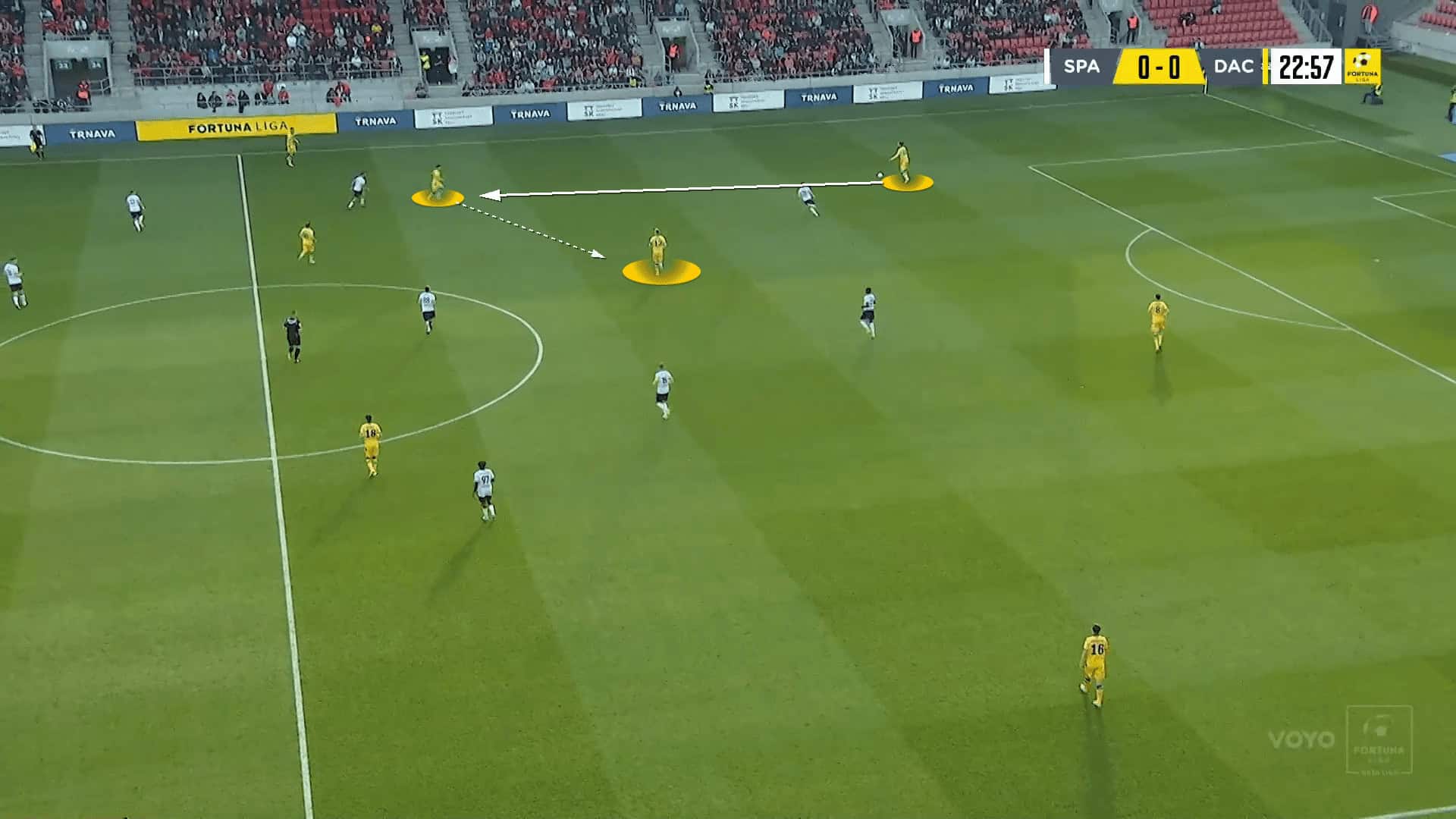
In this sense, the centre-backs are the main distributors of the team.
Dominik Kružliak, Ahmet Muhamedbegovic, Mateus Brunetti, and especially Spyros Risvanis are players capable of manipulating the tempo of the game, attracting opposition pressure and then allowing the team to progress through precise vertical passing.
However, having players in the backline leading the team’s possession is only one element of the ideas Guľa advocates for.
There are a wide variety of collective movements in front of the player on the ball which dynamise their attacks and allow them to be a very fast/aggressive team in terms of progression.
Risvanis’ signing has been key to their game plan.
He is a centre-back with highly developed technical-tactical attributes to be decisive in the build-up phase, with a lot of resistance under pressure and the ability to read the game so he knows which player to connect with and when/how to do it.
His pass selection is even better than the quality of his execution.
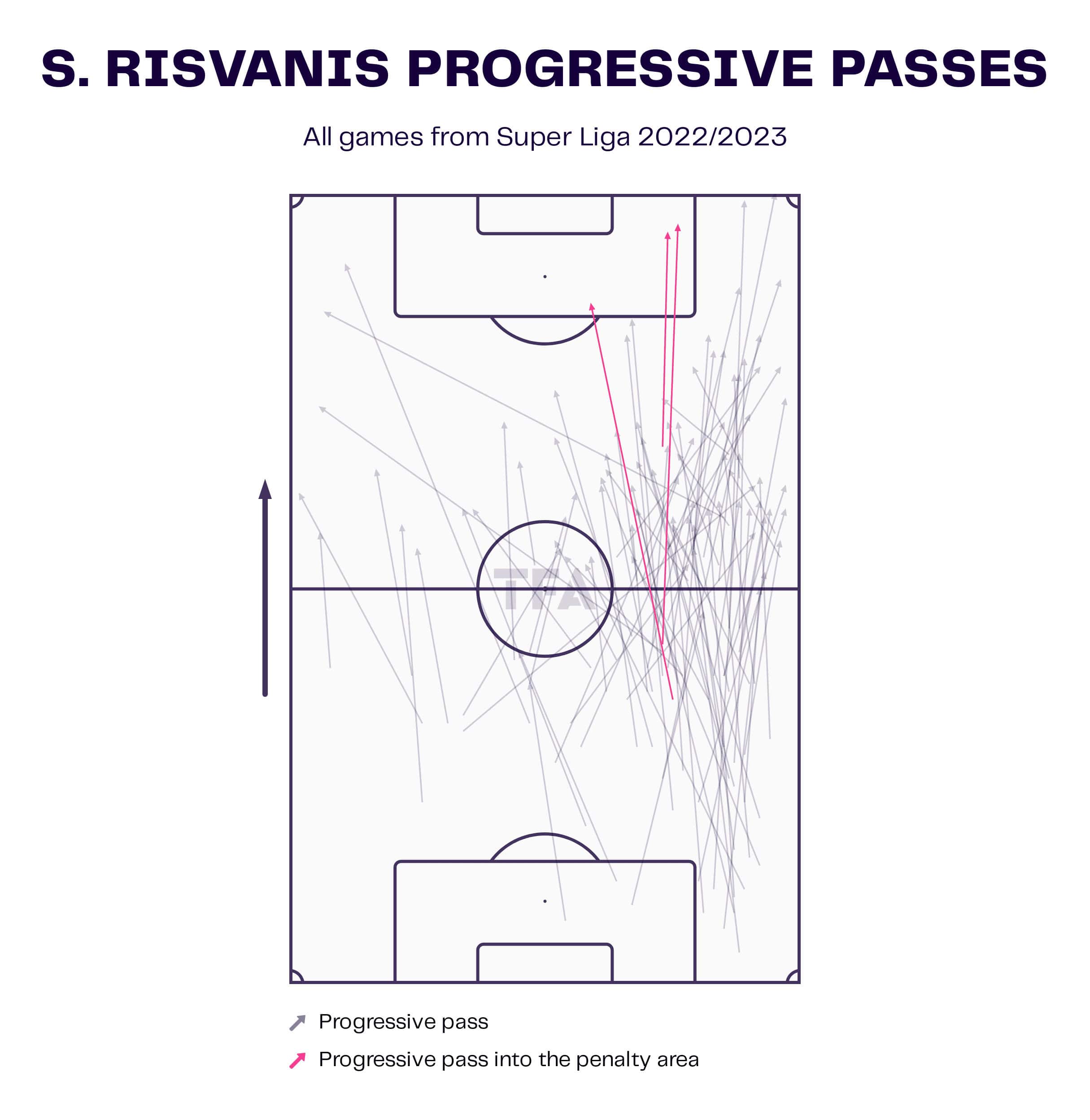
With the presence of the Greek centre-back, Dunajská Streda’s strong side has shifted to the right.
However, they are still a team that benefits the most from side-to-side circulation, as they have quick players to spot the gaps in the opposing block and good mobility of midfielders/attackers to create passing lanes in the free spaces.
Due to how developed their ideas and intentions are in the first phase, the team has faced opponents who have tried to defend in a low-mid block to prevent their front line from being beaten and DAC from being able to progress aggressively.
However, in these scenarios, they tend to make the most of the accumulation of players on the inside to narrow the opposition lines — especially the back four — and use their open full-backs to be activated into space by long passes from the centre-backs who had previously carried the ball into the middle of the pitch.
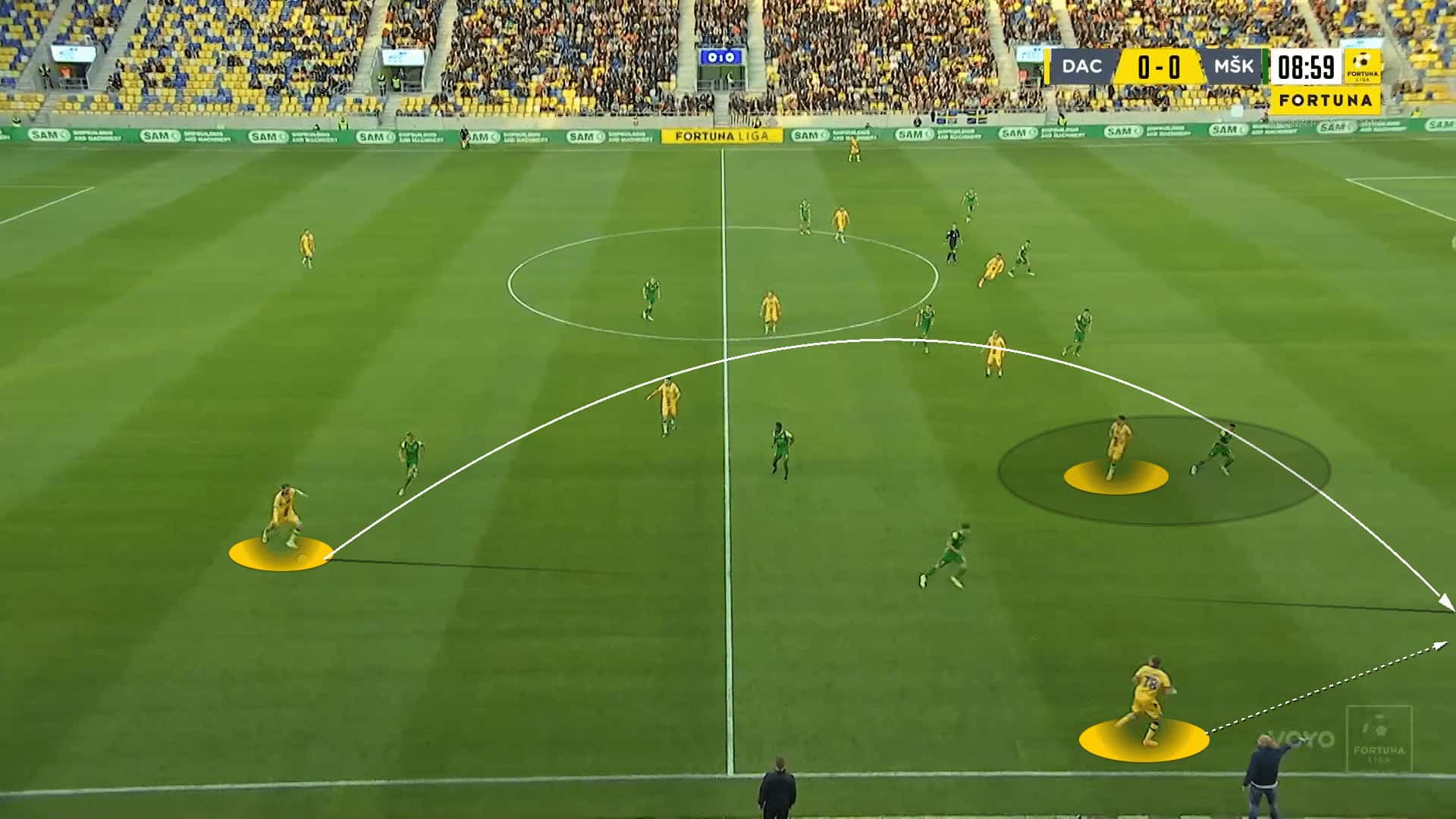
In this way, the team manage to attack the depth with passes and exploit the virtues of their centre-backs to the maximum to lead attacks.
In addition, they also gain a presence on the inside with quick and agile players to receive between the lines, turn and dynamise the associative circuit or directly create dangerous situations.
Beyond the success this season, being a team with very clear and effective progression routes, they have become more predictable in their planning as the games have gone on.
Having a low block solid enough to attract centre-backs carrying the ball and minimise their passing options considerably increases the risk of a potential counter-attack.
A large number of the goals conceded in the latter part of the season have been through crosses, especially in situations where the ball-holder has plenty of time-space to pass.
This is something that relates to certain problems in the team’s defensive transitions, especially when they fail to penetrate the opposition block in the first or second phase and the full-backs are focused on providing width close to the opponent’s defensive line.
For next season, they are a team that will be much stronger as they dominate more resources to progress, as the pressures and approaches of the mid-low blocks will be better and the players will be better adjusted to them.
They will need to be one step ahead of their opponents’ analysis.
Dynamics of dismarking movements and activation of players in width
The passing quality of the team’s centre-backs is boosted by the dynamic off-the-ball movements of the attackers.
Nikola Krstović, Dunajská Streda’s centre-forward, is a clever player to drop back a few metres, create passing lanes in the final third and then link up with players nearby.
However, these moves are very internalised in most of their offensive weapons and are not a unique virtue of any one player in the squad, so Željko Gavrić or Regő Szánthó can also execute them very fluently.
At the same time, one of Guľa’s main hallmarks throughout the season has been the development of dynamics of unmarked-opposing movement between two players in the active zone.
That is, when the centre-back (or the organiser of the play) has time and space to progress through his pass, a player on the same side of the pitch steps up to offer himself as a possible receiver (luring an opponent out of the zone) and another player in the active zone automatically looks to attack the space behind his teammate’s back.
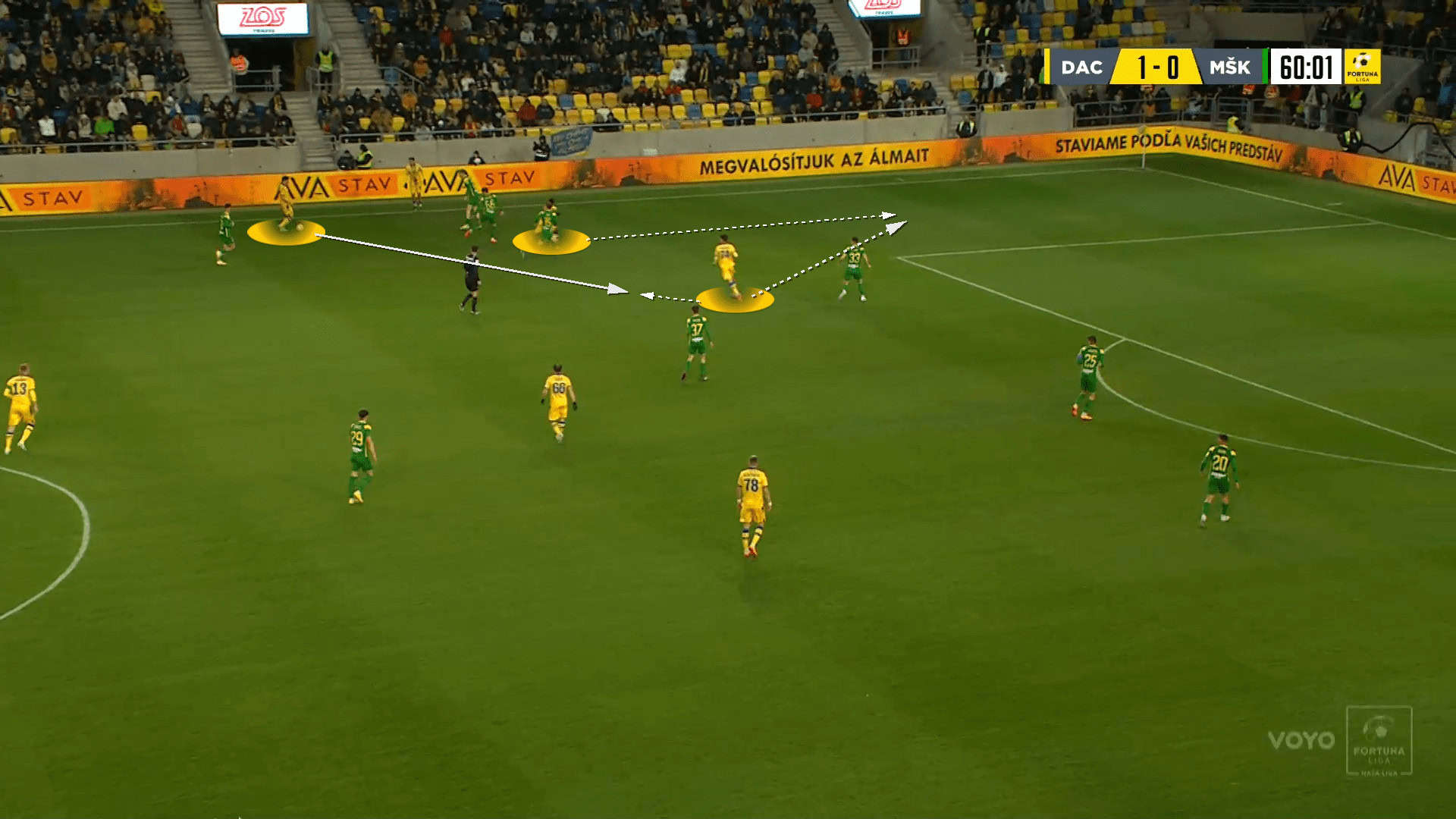
This is one of the reasons why the team always looks to have two permanent wide players and makes the idea of the game even more complete.
With very intelligent centre-backs able to lead their team’s possessions, agile attackers to create inside passing lanes or attack space and dynamise their team’s possessions, the wide players can provide support when the receiver is unable to turn — but also bring the necessary speed to attack space through outside-in movements.
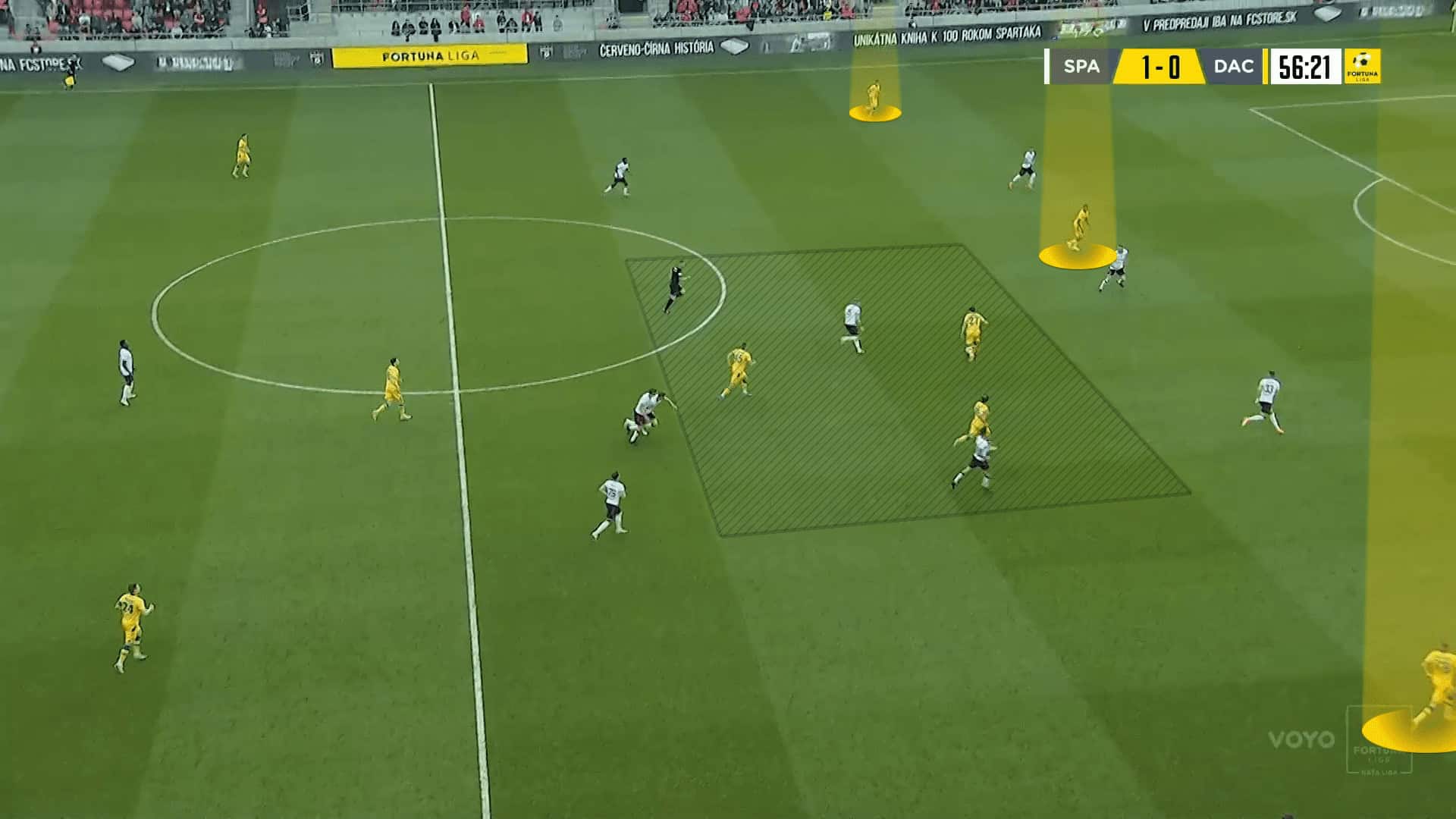
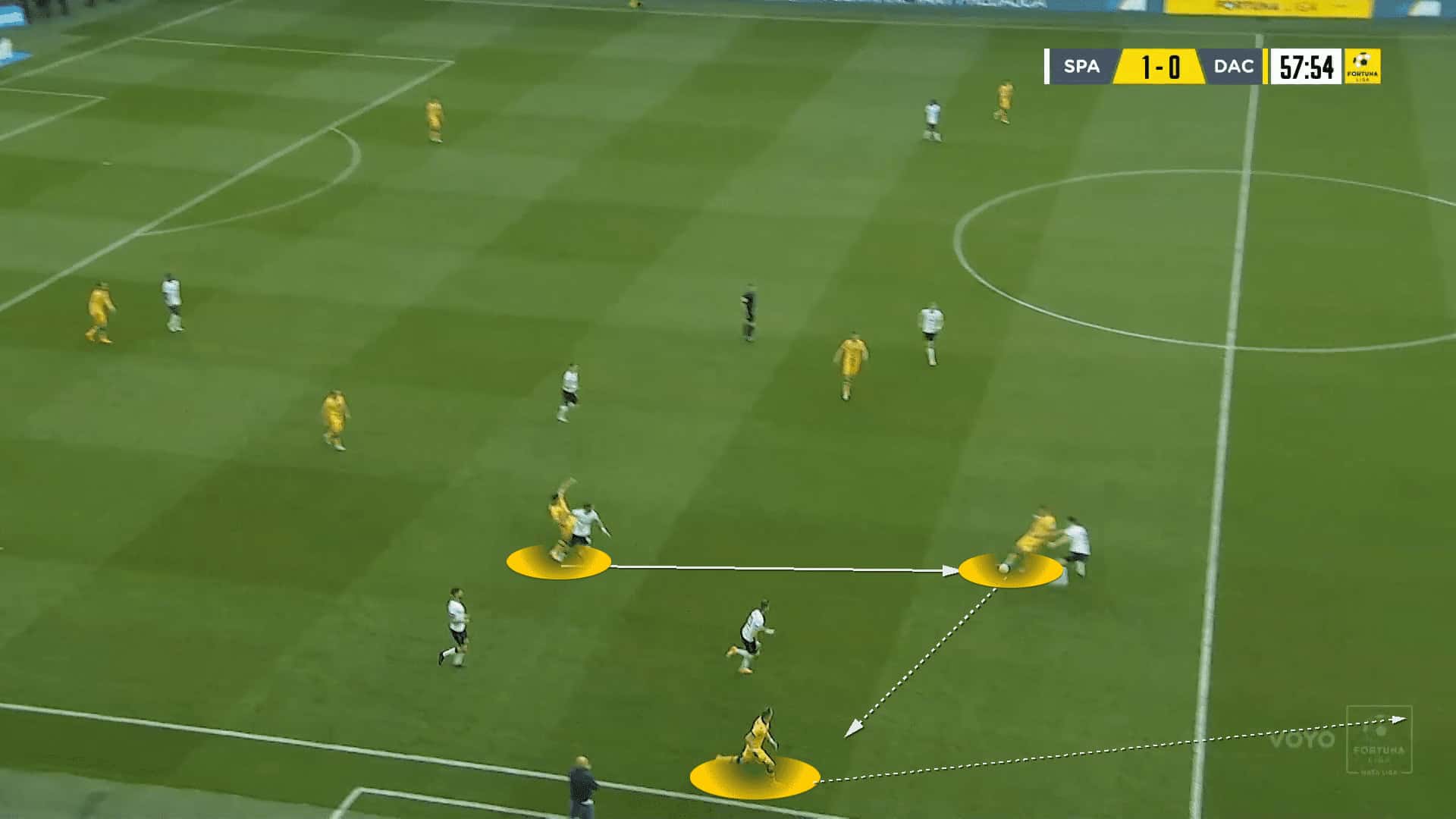
The full-backs are really important parts of Adrián Guľa’s game idea.
The vast majority of names in the squad are players who stand out for their speed and power to carry the ball, but especially to attack space in the opposition half.
Generally, teams that encourage short associative circuits inside benefit greatly from having very powerful wide “jokers” to progress with time and space.
The main reason? The opposition tends to tighten up in order to defend the accumulation of players on the inside, as otherwise (with pieces further apart to mark the full-back in attack) it tends to create gaps in the last line that are ideal for connecting key passes with potential finishers, especially in a team with such a good system of dismarking moves.
Furthermore, in the case of Yhoan Andzounana and Alex Pinto especially, they are players who also have a good reading of the game to attack spaces on the inside, so wingers can drop back to some of the flanks to attract defenders and open up spaces on the inside for the ball carrier to connect with one of the FBs.

Leading possessions through the passing range of the centre-backs and accumulating attackers on the inside is sometimes synonymous with using midfielders as elements of attraction to widen the space between midfielders and opposing defenders, giving their teammates the opportunity to receive more comfortably on the inside.
However, in the 4-3-3 and 4-2-3-1 systems that Guľa tends to use, he prioritises the presence of a player capable of moving very well between lines to contribute to the attacking dynamics — an area in which Dominik Veselovsky tends to fit in very well.
High pressure
Dunajská Streda are the second-most aggressive team in the Slovak league (7.74 PPDA) — behind only Trenčín (7.01) — in terms of pressing.
They seek to exploit the speed of their attackers to the maximum in order to steal the ball in the opposition’s half of the pitch or direct defenders into less favourable areas and reduce their options for progression.
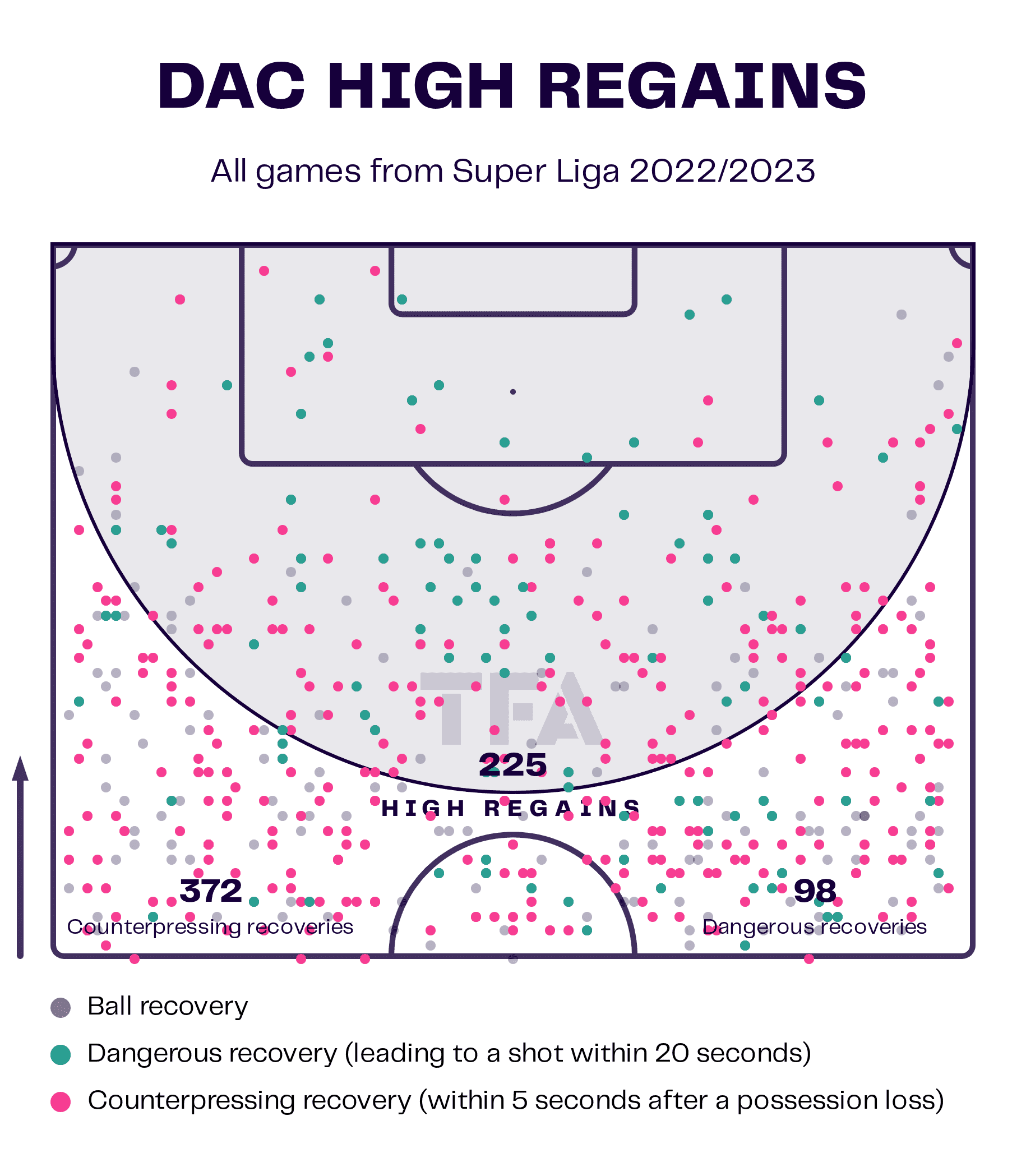
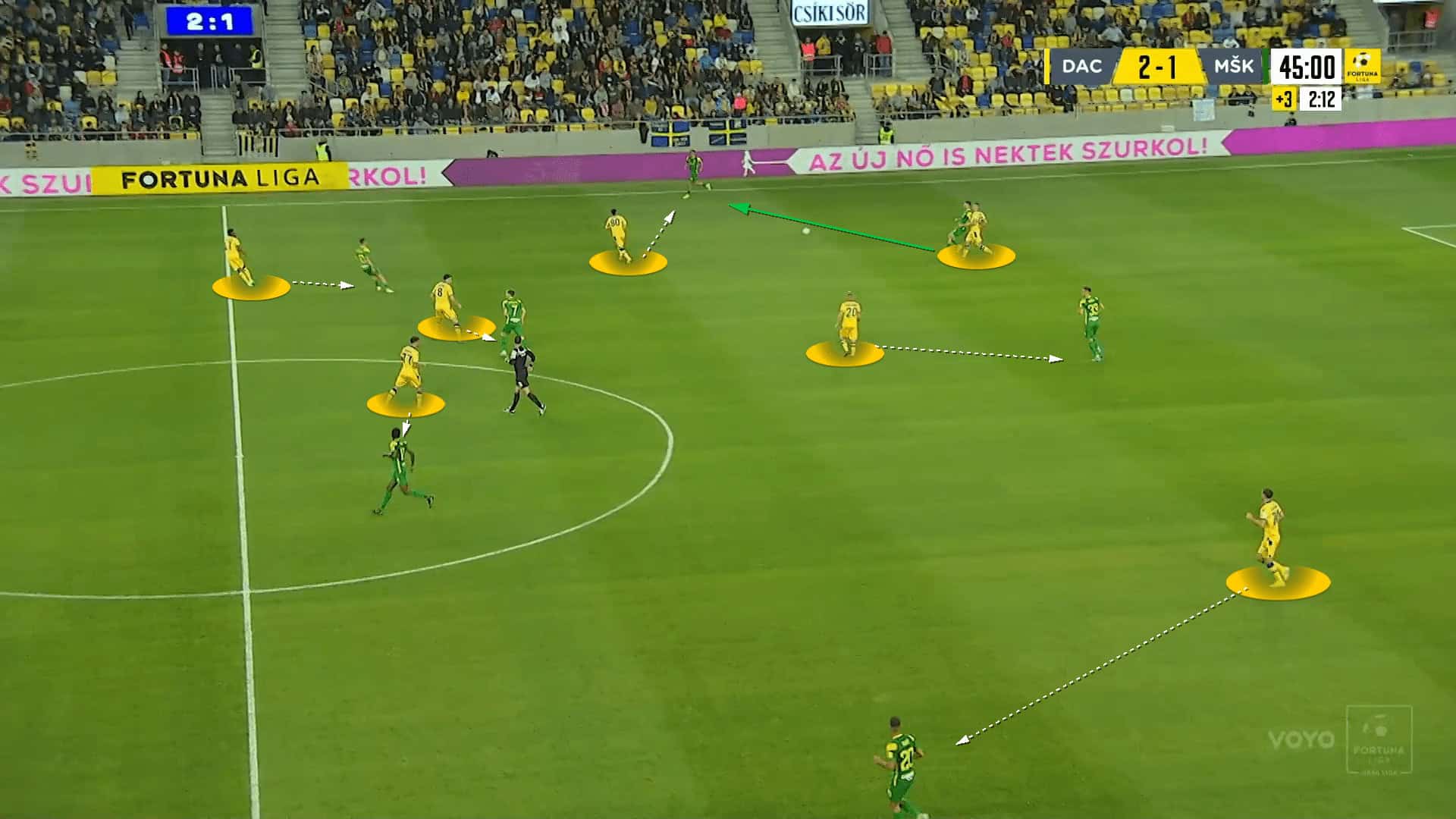
Efforts are often coordinated and very accurate in a league where most teams are far less effective than themselves in the build-up phase.
However, Guľa has shown himself to be a coach with very good ideas for creating pressure traps and not always reducing the chances of progression of opposing centre-backs to the maximum so that they give long passes as a last option.
There is good management of timing to leave full-backs “free” and then press not just that full-back just when they are going to receive the ball through coordinated movements, but also all of their close teammates.
In addition, one of Dunajská Streda’s main virtues lies in the aggressiveness of their recoveries to create dangerous chances.
Once the team recovers the ball in the opponent’s half of the pitch, the collective movement previously carried out allows the players to make short combinations, benefit as much as possible from the spaces in the final third and have more opportunities to activate the potential finishers.
Of course, it is an exercise of great intensity and wear and tear throughout the match, but one that is very much in line with the young, dynamic and athletic players that the club has assembled in its current squad, which is getting closer and closer to winning the first major title in their history.
Conclusion
Adrian Gula is very close to making history by winning the first big title for DAC Dunajska Streda in all its years of existence.
In just one season, the coach has managed to develop an idea that fits very well with the players in the squad and the league’s style of play, becoming one of the most dominant teams in recent years.
Moreover, within his initiative, he has been able to adapt very well to the different opponents in the league and has managed to be superior in most of the games played this year.
It is therefore a win-win relationship for both sides involved.
Everything suggests that coach and club will continue to work together for next season with an even bigger goal (if they become champions this year): a better role in international cups.
Playing in the first round of the UEFA Champions League would not only allow them to retain some talents who are probably on the radar of other clubs, but also to have more capacity to reinforce the squad and to continue the positive dynamics seen throughout this season.
Dunajska Streda, under the ideas of Adrian Gula, has become one of the most interesting teams in Eastern Europe in the 2022/23 season.
The club’s project is producing results and there are still many details to improve in order to continue growing, which is always good news.

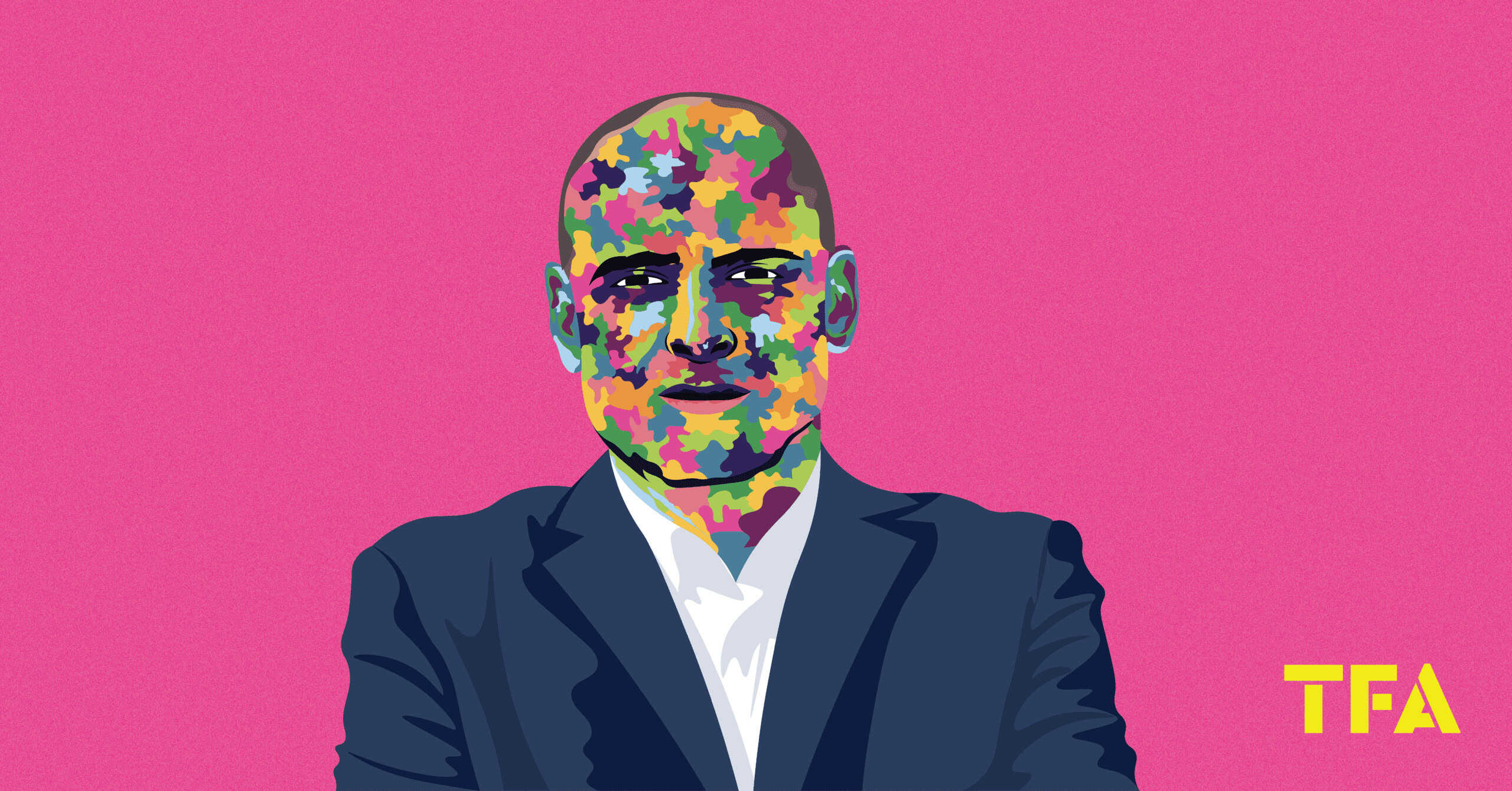



Comments